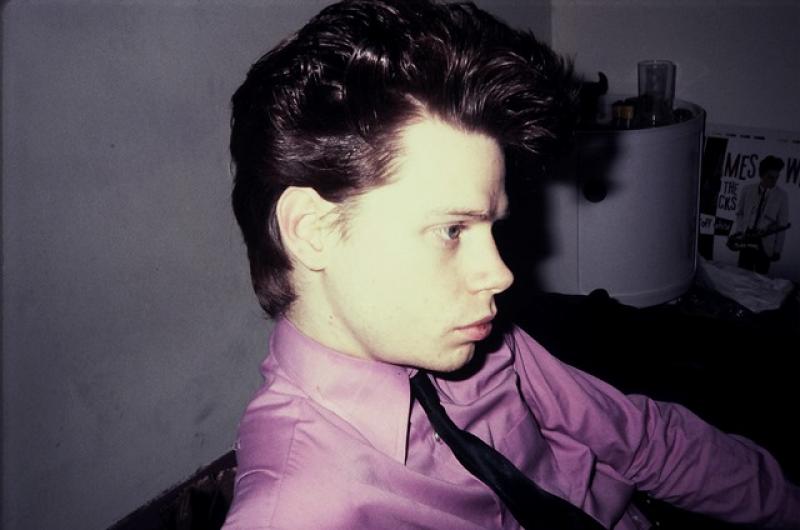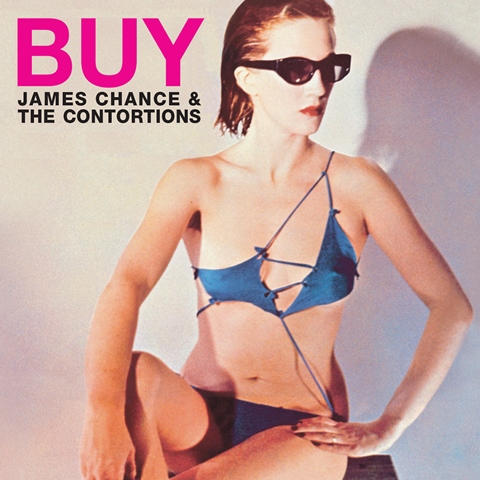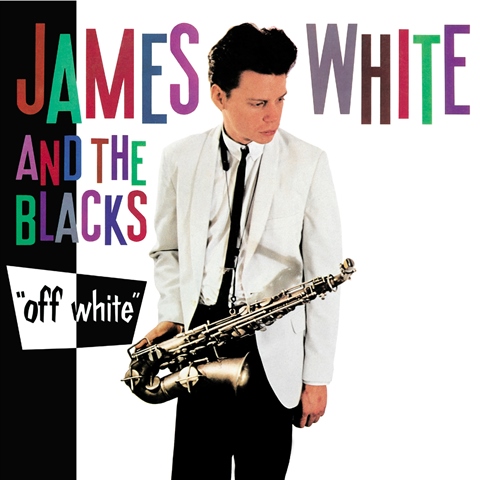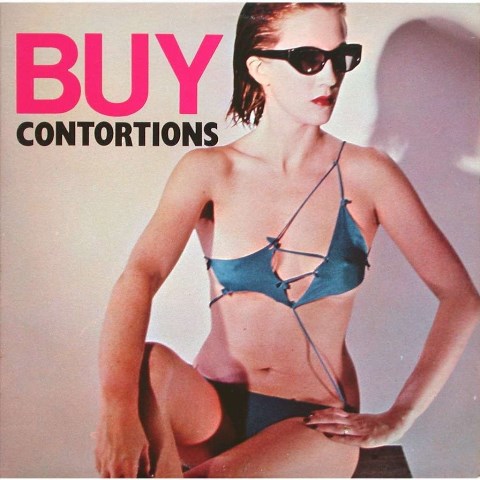Reissue CDs Weekly: James Chance aka James White | reviews, news & interviews
Reissue CDs Weekly: James Chance aka James White
Reissue CDs Weekly: James Chance aka James White
Musical cubism on the first two albums from the confrontational New York no wave pioneer

According to the May 1979 issue of the New York art-paper East Village Eye, James White “is treated [everywhere] with awe and the special consideration lacking in most people's lives.” The adoration was boundless. White is “the star, the proof of the divinity that can be had by those who strive for a life beyond the schemes of men, James White is not an animal creature, James White is one of the breed called God in older times.”
For those who hadn’t realised White was a deity, his more commonly known alter-ego James Chance remained a mere cornerstone of the New York-spawned no wave scene celebrated on the Eno-produced 1978 compilation album No New York. Within its grooves, Chance and his splenetic band Contortions battled for attention alongside the equally fractious D.N.A., Mars and Teenage Jesus and the Jerks. He was also a member of the latter.
 Getting a handle on Chance aka White was not meant to be easy. Of course, he was not a God. Instead, he was the Milwaukee-born James Siegfried, a conservatory-educated musician who moved to New York City in 1975. Adept on keyboards and sax, he had a head full of jazz and found his place in an arty scene where envelope-pushing was rife. The musical straightjacket of punk was mostly side-stepped in New York, yet the newly renamed Chance drew on the confrontational aspects of the era and was wont to start fights with his audience.
Getting a handle on Chance aka White was not meant to be easy. Of course, he was not a God. Instead, he was the Milwaukee-born James Siegfried, a conservatory-educated musician who moved to New York City in 1975. Adept on keyboards and sax, he had a head full of jazz and found his place in an arty scene where envelope-pushing was rife. The musical straightjacket of punk was mostly side-stepped in New York, yet the newly renamed Chance drew on the confrontational aspects of the era and was wont to start fights with his audience.
Buy – credited to Contortions – and Off White – credited to James White and the Blacks – were the first two albums Chance made, both issued in 1979 and recorded by pretty much the same band. Each was issued on ZE, the label set up by Michael Zilkha and Michel Esteban. Chance assumed the further identity for Off White as it was distinct project: Esteban had asked him to make a disco album.
 The reappearance of both brings the opportunity to, indeed, assess whether this is the music of a God. Hardly. Despite the East Village Eye’s idiotic hubris, there is a devotional aspect to each album. As well as jazz, Chance was infatuated with James Brown (hence the name James White). Furthermore, he worked himself into such frenzy on stage he may as well have been in a ritual trance.
The reappearance of both brings the opportunity to, indeed, assess whether this is the music of a God. Hardly. Despite the East Village Eye’s idiotic hubris, there is a devotional aspect to each album. As well as jazz, Chance was infatuated with James Brown (hence the name James White). Furthermore, he worked himself into such frenzy on stage he may as well have been in a ritual trance.
Buy is the album to hear first. It is music as cubism, wildly refracting funk, jazz and soul with cheese-grater guitar, rubbery bass, squawking sax and relentless rhythms. Every cut is a classic and the album defines unhinged despite being entirely deliberate. Off White is less immediately impactful as Chance had produced it to order. Although he had no instructions beyond conceptually addressing disco, it is more scattershot and less direct. Even so, it remains bizarre, energised and – at a stretch – could have been the album Albert Ayler made if he was tasked with trying disco on for size. Both albums are a blast.
 While the music itself remains timeless, this pair of new releases says nothing new. Each repackages CD versions of the albums issued in 2004, reusing the bonus tracks and Michel Esteban’s liner notes from then. Frustratingly, the same liner notes are employed for each package. Furthermore, this is an overview rather than text dedicated to each album and its context. Two new essays should have been written. Also, the digital remasters from 2004 are recycled: these are very dry and lack the mid-range punch of the original vinyl albums. A glitch at the end Buy’s “My Infatuation” interrupts the track moments before it has run its course. Buy comes with a cover crediting the album to James Chance & The Contortions: this is an after-the-fact confabulation. It was originally credited solely to Contortions, which is what the band were called, and the album should be seen as thus otherwise history is rewritten. To play spot the difference, the original sleeve is seen to the right while the new reissue version appears above. It would have good if both albums had been revisited wholesale before hitting the market again.
While the music itself remains timeless, this pair of new releases says nothing new. Each repackages CD versions of the albums issued in 2004, reusing the bonus tracks and Michel Esteban’s liner notes from then. Frustratingly, the same liner notes are employed for each package. Furthermore, this is an overview rather than text dedicated to each album and its context. Two new essays should have been written. Also, the digital remasters from 2004 are recycled: these are very dry and lack the mid-range punch of the original vinyl albums. A glitch at the end Buy’s “My Infatuation” interrupts the track moments before it has run its course. Buy comes with a cover crediting the album to James Chance & The Contortions: this is an after-the-fact confabulation. It was originally credited solely to Contortions, which is what the band were called, and the album should be seen as thus otherwise history is rewritten. To play spot the difference, the original sleeve is seen to the right while the new reissue version appears above. It would have good if both albums had been revisited wholesale before hitting the market again.
Nonetheless, Buy and Off White are fantastic and the fresh availability should be an invitation to check out the true one-off that is James Chance. For anyone who wants to dig in to what was originally intended, neither album is rare and originals of Off White fetch around £10. Buy hits £20. The choice is there to be made.
Share this article
The future of Arts Journalism
You can stop theartsdesk.com closing!
We urgently need financing to survive. Our fundraising drive has thus far raised £49,000 but we need to reach £100,000 or we will be forced to close. Please contribute here: https://gofund.me/c3f6033d
And if you can forward this information to anyone who might assist, we’d be grateful.

Subscribe to theartsdesk.com
Thank you for continuing to read our work on theartsdesk.com. For unlimited access to every article in its entirety, including our archive of more than 15,000 pieces, we're asking for £5 per month or £40 per year. We feel it's a very good deal, and hope you do too.
To take a subscription now simply click here.
And if you're looking for that extra gift for a friend or family member, why not treat them to a theartsdesk.com gift subscription?
more New music
 Solar Eyes, Hare & Hounds, Birmingham review - local lads lay down some new tunes for a home crowd
Psychedelic indie dance music marinated in swirling dry ice
Solar Eyes, Hare & Hounds, Birmingham review - local lads lay down some new tunes for a home crowd
Psychedelic indie dance music marinated in swirling dry ice
 The Lemonheads' 'Love Chant' is a fine return to form
Evan Dando finally gets back in the saddle with an album of new tunes
The Lemonheads' 'Love Chant' is a fine return to form
Evan Dando finally gets back in the saddle with an album of new tunes
 Music Reissues Weekly: Evie Sands - I Can’t Let Go
Diligent, treasure-packed tribute to one of Sixties’ America’s great vocal stylists
Music Reissues Weekly: Evie Sands - I Can’t Let Go
Diligent, treasure-packed tribute to one of Sixties’ America’s great vocal stylists
 'Deadbeat': Tame Impala's downbeat rave-inspired latest
Fifth album from Australian project grooves but falls flat
'Deadbeat': Tame Impala's downbeat rave-inspired latest
Fifth album from Australian project grooves but falls flat
 Heartbreak and soaring beauty on Chrissie Hynde & Pals' Duets Special
The great Pretender at her most romantic and on the form of her life
Heartbreak and soaring beauty on Chrissie Hynde & Pals' Duets Special
The great Pretender at her most romantic and on the form of her life
 The Last Dinner Party's 'From the Pyre' is as enjoyable as it is over-the-top
Musically sophisticated five-piece ramp up the excesses but remain contagiously pop
The Last Dinner Party's 'From the Pyre' is as enjoyable as it is over-the-top
Musically sophisticated five-piece ramp up the excesses but remain contagiously pop
 Moroccan Gnawa comes to Manhattan with 'Saha Gnawa'
Trance and tradition meet Afrofuturism in Manhattan
Moroccan Gnawa comes to Manhattan with 'Saha Gnawa'
Trance and tradition meet Afrofuturism in Manhattan
 Soulwax’s 'All Systems Are Lying' lays down some tasty yet gritty electro-pop
Belgian dancefloor veterans return to the fray with a dark, pop-orientated sound
Soulwax’s 'All Systems Are Lying' lays down some tasty yet gritty electro-pop
Belgian dancefloor veterans return to the fray with a dark, pop-orientated sound
 Music Reissues Weekly: Marc and the Mambas - Three Black Nights Of Little Black Bites
When Marc Almond took time out from Soft Cell
Music Reissues Weekly: Marc and the Mambas - Three Black Nights Of Little Black Bites
When Marc Almond took time out from Soft Cell
 Album: Mobb Deep - Infinite
A solid tribute to a legendary history
Album: Mobb Deep - Infinite
A solid tribute to a legendary history
 Album: Boz Scaggs - Detour
Smooth and soulful standards from an old pro
Album: Boz Scaggs - Detour
Smooth and soulful standards from an old pro
 Emily A. Sprague realises a Japanese dream on 'Cloud Time'
A set of live improvisations that drift in and out of real beauty
Emily A. Sprague realises a Japanese dream on 'Cloud Time'
A set of live improvisations that drift in and out of real beauty

Add comment